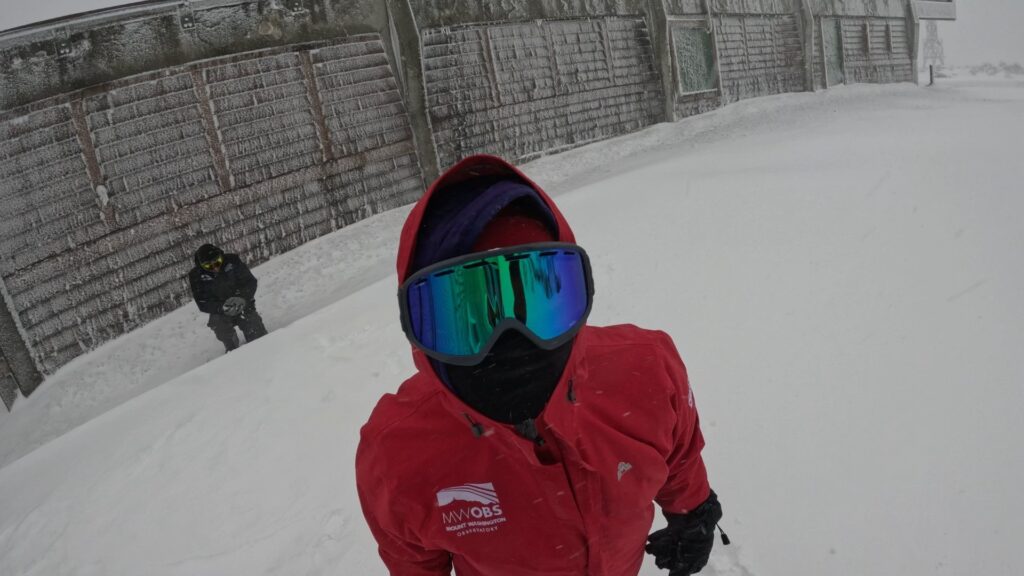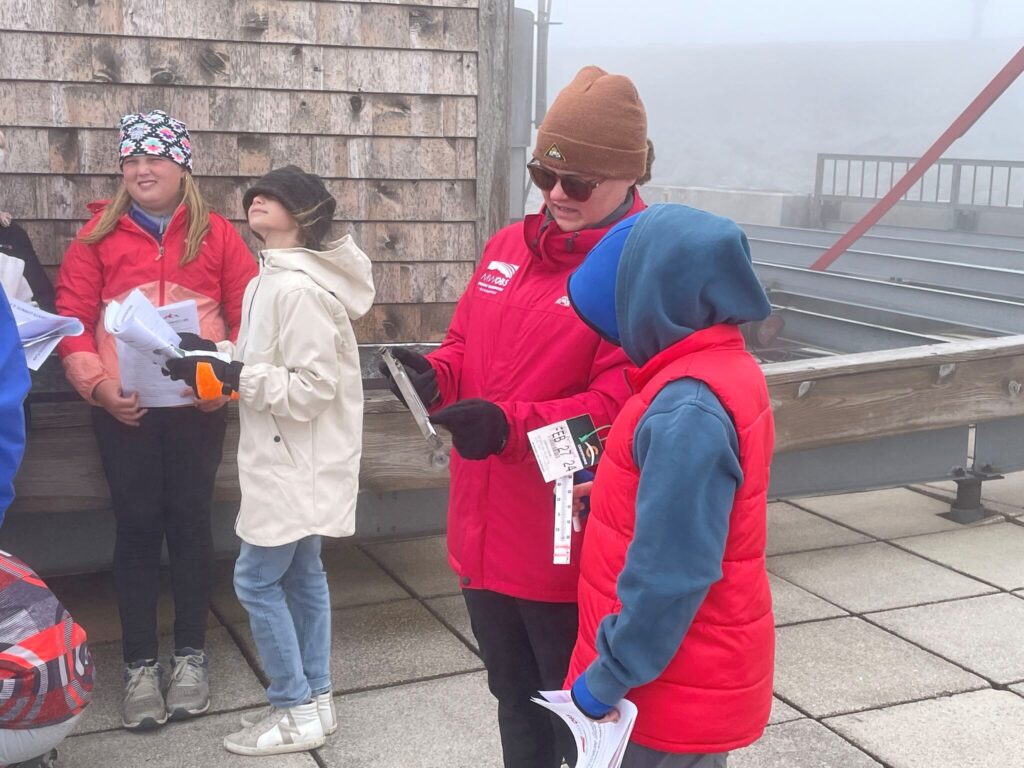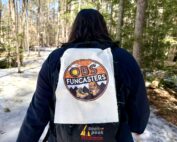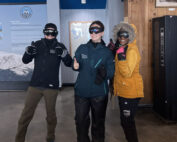From Intern to Educator to Observer: My Next Chapter with the Obs
By Amy Cotter
For the past year and a half, I have worked with Mount Washington Observatory in a variety of positions. My journey with the Obs began in August 2023 as a fall summit intern, after which I moved into a seasonal educator position in January 2024, followed by a permanent educator position starting June 2024, and now, come February 2025, I have completed my first full, official shift as a Weather Observer atop Mount Washington!
As a summit intern, I worked a week on/week off schedule. During these nine weeks on, I had the opportunity to provide weather station tours, forecast for the higher summits of New Hampshire, conduct research on rain-on-snow events on the summit, and gain competency in summit operations and basic weather observations. It was an incredible learning opportunity, and I made so many amazing memories with my shift, which included Weather Observers Alex Branton, Charlie Peachey, and Alexis George.

POV photo from Weather Observer Alex Branton while she, Observer Charlie Peachey, and I had a snowball fight.
Near the end of my internship, a seasonal educator position opened up. With experience giving tours, doing our Facebook Live weekend forecast, and helping Weather Observer and Education Specialist Alex Branton with some of her virtual programs, this educational outreach felt like a natural next step in my career.
Over the next several months, I worked closely with Jackie Bellefontaine, School Programs Coordinator, Brian Fitzgerald, Director of Education, and (from May-October) Amelia Gross, AmeriCorps School Programs Educator in developing and teaching new in-school, field trip, and after-school programs. Working with over 1,000 students across the states of VT, ME, and NH was an incredibly rewarding privilege.

Educators Jackie Bellefontaine (left), myself, and Amelia Gross during school field trip season in front of a train with the Cog Railway.
Come August, I ran our very first MWOBS summer camp, Storm Scouts, which was one of the highlights of my time as an educator. A week-long session allowed us to develop a more immersive and in-depth program than our team had before. Bringing students up to the summit and into our weather station for the majority of the week allowed us to really spark the excitement and passion for weather and climate science in these middle schoolers. Amongst lots of games and time spent outdoors, we learned about the different climate zones on Mount Washington, careers in meteorology, forecasting, weather instruments, and weather observations.

Teaching a Storm Scout how to use a sling psychrometer to measure dry and wet-bulb temperatures.
In January, I moved into an open Weather Observer position, which brings us to this moment, having just completed my first few full weeks as an Observer here on the summit. I clarify “full,” “official,” and “as an Observer” because between my internship, shorter stints helping to cover and support summit operations, my work on the summit as an educator, and a scheduled transitional period between being an educator and an observer (during which I spent about half my time on the summit and half my time helping wrap up education program tasks), our weather station already feels like home.
Despite my prior work on the summit, being an Observer has presented new and rewarding learning opportunities, and I’ve spent my time thus far diving into these opportunities, new tasks, and challenges, some of which I’ve highlighted below.
Studying for my METAR exam: Our hourly weather observations are submitted to our local NWS station in Grey, Maine, and in order to officially record and submit these observations, all Observers must be METAR, or Meteorological Aerodrome Report, certified with NWS. METAR is a format for reporting weather information that is predominantly used by aircraft pilots and meteorologists, and an Observer’s first few months is spent studying to pass this exam. For more information on METAR code, see Observer Alexis George’s blog post here.
Adjusting to the Observer schedule: When I was an intern, I worked the week-on/week-off schedule. As an educator, I was able to settle more into the Mount Washington Valley with a somewhat typical M-F, 9-5 schedule. As an Observer, I have shifted back to the week-on/week-off schedule, working 10-hour days for 8 days at a time. As a day observer, my shift starts at 5:30 am and typically ends with dinnertime at 6 pm. I’ve also had the opportunity to work with new coworkers, as the shift team I’ve joined is the one I worked opposite of as an intern! Getting to know both the Observers and the Interns has been such an awesome experience, and I am so excited to continue working with them.
Media attention: As a Weather Observer and Education Specialist, one of my new responsibilities is handling media outreach. This is through our Facebook Live weekend forecasts and responding to media outlet interview requests. These interviews are an awesome, albeit occasionally nerve-wracking, opportunity to communicate with the public on what we do here at the Observatory, why we do our work, and about mountain weather conditions!
Honing my forecasting skills: With winter weather patterns, I’ve been able to hone the higher summits forecasting skills I developed as an intern. As a fall intern, I only got a taste of winter weather towards the end of my internship, so being up here for true winter conditions has been exciting and has presented me the opportunity to focus on forecasting winter storms, snowfall, winds, and other conditions!
Adjusting to winter: As I was only working on the summit full-time until December of 2023, officially being an Observer up here in the dead of January is an entirely different experience. On my first day training, I was already heading up to the top of the weather tower to de-ice our instruments in 100 mph sustained winds, which is quite an adrenaline rush.

Taking a weather observation during my first shift captured by co-day observer Karl Philippoff.
Despite the difficulties these conditions present, living and working in the extreme weather that we study and forecast for is the most exciting and rewarding part of the job, and I am so excited to experience the rest of what winter and my time as an Observer have in store!
Team Flags Return for Seek the Peak’s 25th Anniversary
Team Flags Return for Seek the Peak's 25th Anniversary By MWOBS Staff Mount Washington Observatory is looking forward to continuing a much-loved tradition for Seek the Peak’s 25th Anniversary: Team flags. In inviting teams
Meet Summer Interns Zakiya, Max and Maddie
Meet Summer Interns Zakiya, Max and Maddie By MWOBS Staff We are excited to welcome six teammates to the summit of Mount Washington this summer! During their internship, these students and graduates will play
Saying Goodbye to the Summit
Saying Goodbye to the Summit By Alexis George After an extraordinary last three years working as a Weather Observer and Meteorologist, I am excited to pursue a different career. As sad I as am




